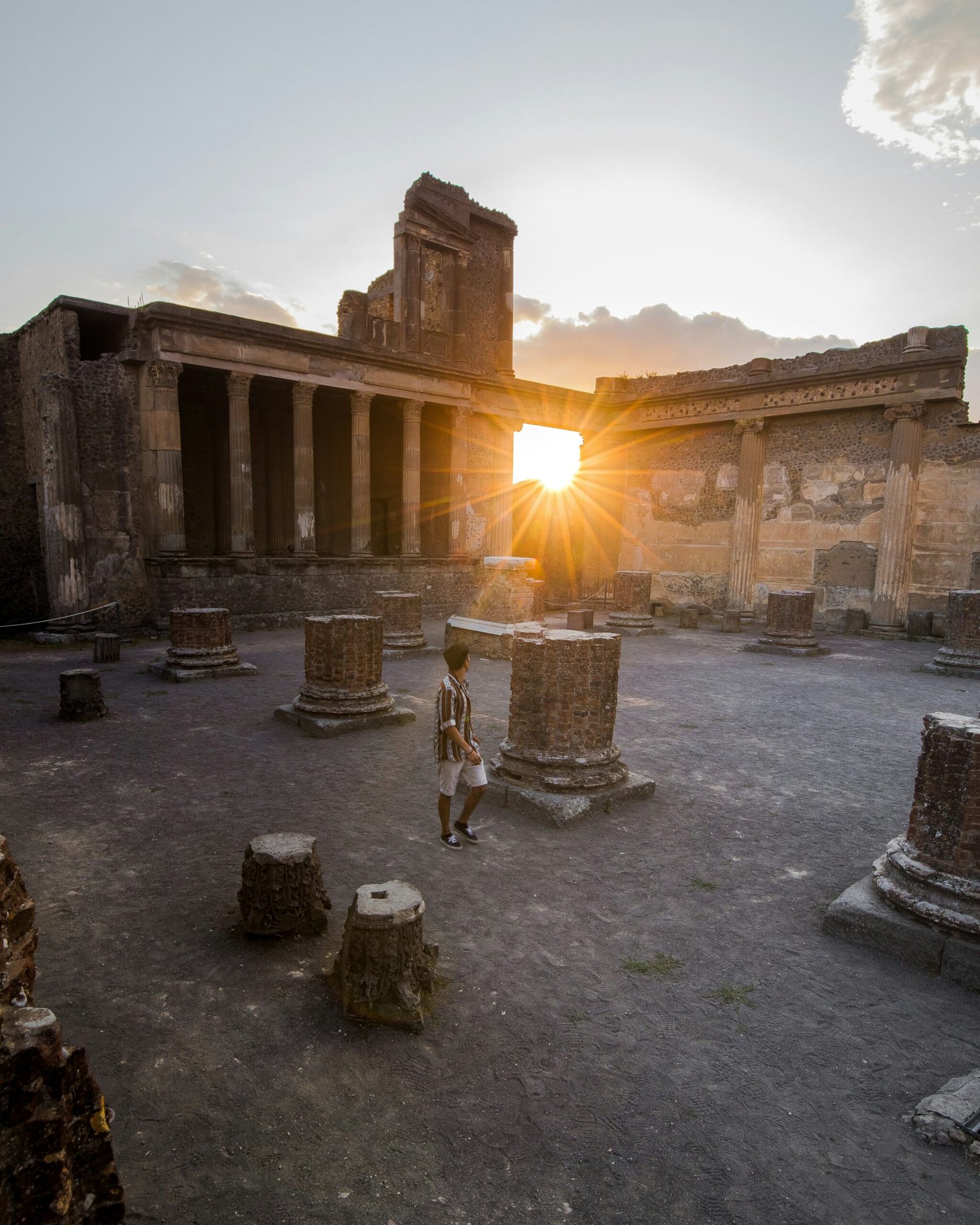A Pompeii Map is an essential tool for anyone wishing to explore the fascinating ruins of this ancient Roman city. Nestled near modern Naples, Pompeii offers a unique glimpse into the past, frozen in time by the catastrophic eruption of Mount Vesuvius in 79 AD. With a well-detailed map, visitors can navigate the sprawling archaeological site with ease, uncovering its many secrets and marvels.

Using a Pompeii Map, you can explore the city’s remarkable preservation, with its streets, buildings, and artifacts offering an unparalleled window into ancient Roman life. From grand villas to bustling marketplaces, the ruins of Pompeii tell the story of a vibrant community abruptly halted by nature’s fury. A comprehensive map highlights these significant sites, guiding you through the city’s intricate layout.
The Pompeii Map not only aids in navigation but also enhances your understanding of the site’s historical and cultural significance. Each marked location on the map reveals a piece of Pompeii’s rich tapestry, from the grandeur of the amphitheater to the intimate details of private homes. As you walk the ancient streets, the map serves as your gateway to the past, making the experience both educational and immersive.
For first-time visitors, a Pompeii Map is indispensable. The site is vast, and without proper guidance, it’s easy to miss key attractions. The map ensures you see all the important landmarks, including the Forum, the Baths, and the famous plaster casts of the victims. By following the map, you can efficiently plan your visit, ensuring a comprehensive exploration of this historic site.
A detailed Pompeii Map also helps you appreciate the city’s sophisticated urban planning. The grid layout of the streets, the organization of residential and commercial areas, and the placement of public buildings reflect the advanced engineering and architectural skills of the ancient Romans. Understanding this layout through the map enhances your appreciation of Pompeii’s urban development.
Moreover, the Pompeii Map provides context to the various artifacts and frescoes found throughout the site. Knowing the location and historical background of these items allows for a deeper connection to the ancient inhabitants. Whether you’re admiring the intricate mosaics or the vivid frescoes, the map enriches your visual experience by tying each piece to its original setting.
Visitors often use the Pompeii Map to plan thematic tours, focusing on different aspects of ancient life, such as commerce, religion, or daily routines. By selecting specific routes on the map, you can tailor your visit to match your interests. This personalized approach ensures a more engaging and meaningful exploration of Pompeii.
Finally, a Pompeii Map is crucial for understanding the sheer scale of the disaster that befell the city. The marked areas of excavation, the locations of significant finds, and the extent of the preserved ruins all paint a vivid picture of the eruption’s impact. This perspective underscores the importance of Pompeii as a testament to the power of nature and the resilience of human history.
The Importance of a Detailed Map of Pompeii Ruins
Having a map of Pompeii ruins is crucial for any visitor aiming to fully appreciate the ancient city’s layout and significance. The map helps navigate the vast site, ensuring that key locations such as the Forum, the amphitheater, and the Villa of the Mysteries are not missed. Each of these sites tells a unique story about the daily lives of the inhabitants before the catastrophic eruption.
The Forum was the center of public life in Pompeii, a bustling marketplace surrounded by important government buildings. A detailed map highlights this area, allowing you to envision the vibrancy and activity that once filled these streets. The amphitheater, one of the oldest surviving Roman amphitheaters, is another must-see, offering insights into the entertainment and social gatherings of ancient Pompeii.
Exploring the residential areas, a map of Pompeii ruins guides you through the grand homes of the wealthy, such as the House of the Faun and the House of the Vettii. These homes are adorned with intricate mosaics and frescoes, depicting scenes from mythology and daily life. The map helps you locate these artistic treasures, enhancing your appreciation of ancient Roman art and culture.
A comprehensive map also points out the public baths, which were an essential part of Roman social life. The Stabian Baths, for instance, are well-preserved and provide a glimpse into the advanced engineering skills of the Romans. The map details the layout of these baths, from the changing rooms to the heated pools, offering a deeper understanding of Roman bathing practices.
For those interested in religious aspects, the map of Pompeii ruins includes the various temples and shrines scattered throughout the city. The Temple of Apollo and the Temple of Jupiter are significant landmarks that reflect the religious diversity and practices of the time. By following the map, you can explore these sacred spaces and learn about the deities worshipped by the Pompeians.
The map of Pompeii ruins also highlights the many shops and taverns that lined the streets, providing a glimpse into the commercial life of the city. These establishments offer clues about the economic activities and daily routines of the ancient inhabitants. With the map’s guidance, you can trace the routes of merchants and customers, bringing the bustling marketplace to life.
Another important feature marked on the map is the necropolis, the city’s burial grounds. These areas provide valuable insights into the funerary practices and beliefs about the afterlife. The map helps locate these sites, where you can observe the various tombs and grave markers that have been uncovered.
In addition to these major landmarks, a detailed map of Pompeii ruins includes lesser-known areas that are equally fascinating. For example, the Lupanar, the city’s brothel, offers a unique perspective on the social and cultural norms of the time. The map ensures that these intriguing sites are not overlooked, providing a comprehensive tour of Pompeii.
Having a map of Pompeii ruins transforms your visit into a well-organized and enriching experience. It not only helps you navigate the vast site but also deepens your understanding of the ancient city’s layout, architecture, and daily life. With the map in hand, you can uncover the wonders of Pompeii with ease and appreciation.
Essential Features of a Pompeii Visitor Map
When visiting the ancient city of Pompeii, having a well-designed Pompeii visitor map is essential for a fulfilling and organized experience. Such a map should include several key features to help you make the most of your visit.
1. Comprehensive Landmark Markers
A good Pompeii visitor map should clearly mark all significant landmarks, such as the Forum, amphitheater, and major villas. This ensures that you do not miss any important historical sites.
2. Detailed Pathways
The map should show detailed pathways, including both main streets and smaller alleys. This helps in navigating the vast site efficiently.
3. Restroom and Facility Locations
Restroom and facility locations are crucial for a comfortable visit. A comprehensive map will mark these facilities for easy access.
4. Accessibility Information
Information about accessible routes for visitors with mobility issues is important. The map should highlight wheelchair-friendly paths and entrances.
| Feature | Description |
|---|---|
| Comprehensive Landmark Markers | Marks all significant historical sites |
| Detailed Pathways | Shows main streets and smaller alleys |
| Restroom Locations | Indicates the location of restrooms and facilities |
| Accessibility Information | Highlights accessible routes for visitors |
5. Emergency Exits and First Aid Points
Knowing where emergency exits and first aid points are located can be vital. A visitor map should clearly mark these points.
6. Audio Guide Points
If the site offers audio guides, the map should indicate where you can pick up and return these guides.
7. Dining and Refreshment Areas
The map should also show dining and refreshment areas where visitors can take a break and enjoy some food or drink.
8. Interactive QR Codes
Modern visitor maps often include QR codes that can be scanned for more information about specific sites. This interactive feature enhances the visitor experience.
For more information on planning your visit, you can check out the official Pompeii website.
Having a Pompeii visitor map with these features ensures that you can navigate the ancient city with ease, making your visit both enjoyable and educational.
Understanding the Pompeii Site Map
A Pompeii site map is an invaluable tool for anyone interested in exploring the archaeological site comprehensively. This map provides detailed information about the layout and significant areas within Pompeii, enhancing your understanding of this ancient city.
The Layout of Pompeii
The Pompeii site map reveals the city’s sophisticated urban planning. The streets are laid out in a grid pattern, typical of Roman cities, with main roads intersecting with smaller alleys. This layout facilitated efficient movement and organization within the city.
Key Areas and Buildings
The map highlights key areas and buildings, such as the Forum, the central public space used for gatherings and markets. Adjacent to the Forum are important public buildings, including the Basilica, the Temple of Apollo, and the Macellum (market).
Residential Areas
The residential areas, marked on the Pompeii site map, include both modest homes and grand villas. The House of the Faun and the House of the Vettii are examples of luxurious residences, featuring elaborate decorations and expansive courtyards.
“The House of the Faun is one of the largest and most impressive residences in Pompeii, showcasing the wealth and status of its owner.” – Pompeii Archaeological Guide
Public Baths
Public baths were an essential part of Roman life. The Stabian Baths, highlighted on the map, are among the oldest and best-preserved baths in Pompeii. The map details the different
sections of the baths, including the frigidarium (cold room), tepidarium (warm room), and caldarium (hot room).
Entertainment Venues
Entertainment was a significant aspect of Pompeian culture. The amphitheater and the smaller theater, marked on the Pompeii site map, were venues for gladiatorial games and theatrical performances. These structures reflect the social and cultural life of the city.
Commercial Districts
The commercial districts, including shops and taverns, are also indicated on the map. These areas provide insights into the economic activities and daily routines of the inhabitants. The Forum’s surrounding markets and the numerous street-side shops were bustling centers of trade.
Temples and Religious Sites
Religious life in Pompeii is represented by various temples and shrines scattered throughout the city. The Pompeii site map marks these religious sites, such as the Temple of Jupiter and the Temple of Isis, reflecting the diverse religious practices of the time.
Exploring Pompeii
Exploring Pompeii with a detailed site map allows for a more structured and informative visit. The map not only helps in navigating the vast site but also provides context to the various structures and artifacts found throughout the city.
Understanding the layout and significant areas within Pompeii through the Pompeii site map enhances your appreciation of the ancient city’s urban planning, architecture, and daily life.
Exploring Pompeii: Must-See Attractions
Exploring Pompeii is a journey through time, and a Pompeii Map is your guide to uncovering the city’s most fascinating attractions. With its detailed layout and marked sites, the map ensures you experience all the essential locations.
The Forum
The Forum is the heart of ancient Pompeii. This central public space was used for gatherings, markets, and political activities. Surrounded by important buildings, the Forum is a must-see for anyone interested in the social and political life of Pompeii.
The Amphitheater
One of the oldest surviving Roman amphitheaters, this structure hosted gladiatorial games and other spectacles. Its size and preservation make it a highlight for visitors.
The House of the Faun
This grand villa is renowned for its elaborate mosaics, including the famous Alexander Mosaic. The House of the Faun provides a glimpse into the luxurious lifestyle of Pompeii’s elite.
The Stabian Baths
The Stabian Baths are among the best-preserved baths in Pompeii. They offer insights into the public bathing culture of the Romans, with separate areas for different types of baths and social interactions.
The Villa of the Mysteries
Located on the outskirts of Pompeii, this villa is famous for its well-preserved frescoes depicting mysterious Dionysian rituals. It is a must-visit for art enthusiasts.
The Bakery of Popidio Prisco
One of several bakeries in Pompeii, this site showcases the city’s advanced baking techniques and the daily life of its inhabitants. The preserved ovens and mills provide a tangible connection to ancient times.
The Temple of Apollo
As one of the oldest temples in Pompeii, the Temple of Apollo reflects the religious practices and architectural styles of the time. Its prominent location near the Forum underscores its importance in public life.
The Garden of the Fugitives
This poignant site contains plaster casts of victims of the eruption, captured in their final moments. It is a somber reminder of the catastrophic event that buried Pompeii.
Visiting Pompeii
Visiting Pompeii with a detailed map ensures you don’t miss any of these essential attractions. Each site provides a unique perspective on the life and culture of this ancient city, making your exploration both educational and immersive.
Enhancing Your Visit with a Pompeii Map
A Pompeii Map is not just a navigation tool; it enhances your visit by providing context and background information for each site. Here are some ways to make the most of your Pompeii map:
Plan Your Route
Before you start exploring, use the map to plan your route. Identify the key sites you want to visit and map out a logical path to follow. This ensures you cover all major attractions without backtracking.
Use Audio Guides
Many sites within Pompeii offer audio guides that provide detailed information about the history and significance of each location. The map often indicates where you can pick up and return these guides.
Take Notes
Bring a notebook or use a digital device to take notes as you explore. Jotting down observations and insights helps reinforce what you learn and makes your visit more engaging.
Photography
Use the map to identify the best spots for photography. Many sites offer stunning views and unique angles that are perfect for capturing memorable images of your visit.
Explore Off the Beaten Path
While major attractions are a must-see, the map can also guide you to lesser-known sites that offer unique insights into Pompeian life. These hidden gems are often less crowded and provide a more intimate experience.
Learn About Preservation Efforts
The map often includes information about ongoing preservation efforts. Understanding the work being done to protect and restore Pompeii adds another layer of appreciation for the site.
Engage with Exhibits
Many areas within Pompeii have informational exhibits that provide context and background about the site. The map helps you locate these exhibits and make the most of the educational opportunities they offer.
Enjoy the Experience
Finally, take your time to enjoy the experience. Pompeii is a vast and complex site with much to offer. A detailed map helps you navigate the ruins and fully appreciate the rich history and culture of this ancient city.
Conclusion: Navigating Ancient Wonders with a Pompeii Map
Using a Pompeii Map is essential for uncovering the ancient wonders of this historic site. From the moment you step into the ruins, the map serves as your guide, ensuring you explore all the key areas and understand their significance. The Forum, amphitheater, and residential villas are just a few of the remarkable locations you’ll discover.
The detailed map of Pompeii ruins allows you to appreciate the city’s advanced urban planning and architectural achievements. As you navigate the grid-like streets, the map provides insights into the daily life, commerce, and culture of Pompeii’s inhabitants. Each marked location reveals a piece of history, from grand public spaces to intimate private homes.
Having a Pompeii visitor map enhances your experience by making it more organized and enjoyable. You can plan your visit efficiently, ensuring you don’t miss any important landmarks. The map’s detailed pathways and facility locations add to the convenience, making your exploration of Pompeii both comprehensive and comfortable.
The Pompeii site map offers a deeper understanding of the city’s layout and key structures. By following the map, you can explore significant areas such as the public baths, entertainment venues, and commercial districts. This structured approach enriches your visit, providing a well-rounded view of ancient Pompeian life.
Exploring Pompeii with a well-detailed map allows you to uncover the city’s many attractions with ease. From the House of the Faun to the Garden of the Fugitives, each site offers a unique perspective on the ancient world. The map guides you through these fascinating locations, ensuring a memorable and educational journey.
Enhancing your visit with a Pompeii Map means more than just finding your way. It involves planning your route, engaging with exhibits, and discovering hidden gems. The map serves as a comprehensive tool that adds depth and context to your exploration, making your visit truly immersive.
In conclusion, a Pompeii Map is your key to navigating the ancient wonders of this extraordinary archaeological site. By using the map to its full potential, you can uncover the rich history, culture, and architecture of Pompeii with ease and appreciation. Whether you’re a first-time visitor or a seasoned traveler, the map transforms your visit into a structured and insightful adventure, ensuring you experience all the marvels that Pompeii has to offer.



